Numerical Study Investigating the Blasting Efficiency of the Long and Large-Diameter Uncharged Hole-Boring Method with Deck Charge Technique
Abstract
:1. Introduction
2. Rock Blasting Using Long and Large-Diameter Uncharged Holes
2.1. Introduction to the LLB Method
2.2. Overview of Rock Fragmentation Process by Blasting
2.3. Comparison of Traditional Cut Methods and the LLB Method
3. Numerical Analysis for the LLB Method
3.1. Analysis Model for the LLB Method
3.2. Material Model and State Equation
3.3. Analysis Results for the LLB Method
4. Modified LLB Method with Deck Charge Technique
4.1. Concept behind the Modified LLB Method
4.2. Analysis Model for Modified LLB Method
4.3. Analysis Results for Modified LLB Method
5. Conclusions
Author Contributions
Funding
Institutional Review Board Statement
Informed Consent Statement
Data Availability Statement
Conflicts of Interest
References
- Langefors, U.; Kihlstrom, B. The Modern Technique of Rock Blasting; Wiley: New York, NY, USA, 1963. [Google Scholar]
- Yu, Z.; Shi, X.Z.; Zhou, J.; Chen, X.; Qiu, X.Y. Effective assessment of blast-induced ground vibration using an optimized random forest model based on a harris hawks optimization algorithm. Appl. Sci. 2020, 10, 1403. [Google Scholar] [CrossRef]
- Singh, S.P. Mechanism of cut blasting. Trans. Inst. Min. Metall. 1995, 104, A134–A138. [Google Scholar]
- Gao, P.F.; Zong, Q.; Cheng, B.; Wang, H.B.; Xu, Y.; Zhang, B.B. Investigation on cutting blasting efficiency of hard rock tunnels under different charge diameters. Appl. Sci. 2022, 19, 9906. [Google Scholar] [CrossRef]
- Zare, S.; Bruland, A. Comparison of tunnel blast design models. Tunn. Undergr. Space Technol. 2006, 21, 533–541. [Google Scholar] [CrossRef]
- Xie, L.X.; Lu, W.B.; Zhang, Q.B.; Jiang, Q.H.; Chen, M.; Zhao, J. Analysis of damage mechanisms and optimization of cut blasting design under high in-situ stresses. Tunn. Undergr. Space Technol. 2017, 66, 19–33. [Google Scholar] [CrossRef]
- An, H.; Song, Y.; Yang, D. Experimental study of the effect of rock blasting with various cutting forms for tunnel excavation using physical model tests. Arch. Civ. Eng. 2021, 67, 599–618. [Google Scholar] [CrossRef]
- Kim, M.S.; Lee, S.S. The efficiency of large hole boring (MSP) method in the reduction of blast-induced vibration. Appl. Sci. 2021, 11, 1814. [Google Scholar] [CrossRef]
- Beak, J.H.; Beak, S.H.; Han, D.H.; Won, A.R.; Kim, C.S. A study on the design of PLHBM. Explos. Blasting 2012, 30, 66–76. [Google Scholar]
- Choi, Y.H.; Kim, M.S.; Lee, S.S. Prediction of vertical alignment of the MSP borehole using artificial neural network. KSCE J. Civ. Eng. 2022, 26, 4330–4337. [Google Scholar] [CrossRef]
- Choi, H.B.; Han, D.H.; Ki, K.C. A study on the decay effect of ground vibration based on the number of PLHBM holes in gneiss area. Explos. Blasting 2016, 34, 1–9. [Google Scholar]
- Kim, M.S.; Kim, C.Y.; Song, M.K.; Lee, S.S. Assessment of the blasting efficiency of a long and large-diameter uncharged hole boring method in tunnel blasting using 3D numerical analysis. Sustainability 2022, 14, 13347. [Google Scholar] [CrossRef]
- Kim, M.S.; Lee, S.S. Investigation of geological conditions beyond the excavation face using a MSP boring data monitoring system. Int. J. Rock Mech. Min. Sci. 2022, 157, 105161–105171. [Google Scholar] [CrossRef]
- Kim, M.S.; Lee, J.K.; Choi, Y.H.; Kim, S.H.; Jeong, K.W.; Kim, K.L.; Lee, S.S. A study on the optimal setting of large uncharged hole boring machine for reducing blast-induced vibration using deep learning. Explos. Blasting 2020, 38, 16–25. [Google Scholar]
- Kim, M.S.; Jung, J.H.; Lee, J.K.; Park, M.S.; Bak, J.H.; Lee, S.S. Development and application of large-diameter cut-hole exploration system for assessment of the geological condition beyond NATM tunnel face. Tunn. Undergr. Space 2021, 31, 1–9. [Google Scholar]
- Hopkinson, B. A method of measuring the pressure produced in the detonation of high explosives or by the impact of bullets. Proc. R. Soc. A Math. Phys. Eng. Sci. 1914, 89, 411–413. [Google Scholar] [CrossRef]
- Kolsky, H. Stress wave in solids. J. Sound Vib. 1964, 1, 88–110. [Google Scholar] [CrossRef]
- Cho, S.H.; Kaneko, K. Influence of the applied pressure waveform on the dynamic fracture processes in rock. Int. J. Rock Mech. Min. 2004, 41, 771–784. [Google Scholar] [CrossRef]
- Chai, S.B.; Li, J.C.; Zhang, Q.B.; Li, H.B.; Li, N.N. Stress wave propagation across a rock mass with two non-parallel joints. Rock Mech. Rock Eng. 2016, 49, 4023–4032. [Google Scholar] [CrossRef]
- Kutter, H.K.; Fairhurst, C. On the fracture process in blasting. Int. J. Rock Mech. Min. Sci. Geomech. Abstr. 1971, 8, 189–202. [Google Scholar] [CrossRef]
- Cheng, B.; Wang, H.B.; Zong, Q.; Xu, Y.; Wang, M.X.; Zhu, N.N. Study on the novel technique of straight hole cutting blasting with a bottom charged central hole exploded supplementally. Arab. J. Geosci. 2021, 14, 2838–2867. [Google Scholar] [CrossRef]
- Alia, A.; Souli, M. High explosive simulation using multi-material formulations. Appl. Therm. Eng. 2006, 26, 1032–1042. [Google Scholar] [CrossRef]
- Johnson, G.R.; Holmquist, T.J. A computational constitutive model for brittle materials subjected to large strains, high strain rates and high pressures. In Shock Wave and High-Strain-Rate Phenomena in Materials; Meyers, M., Murr, L., Staudhammer, K., Eds.; CRC Press: Boca Raton, FL, USA, 1992; pp. 1075–1081. [Google Scholar]
- Johnson, G.R.; Holmquist, T.J. An improved computational constitutive model for brittle materials. AIP Conf. Proc. 1994, 309, 981–984. [Google Scholar] [CrossRef]
- Banadaki, M.M.D.; Mohanty, B. Numerical simulation of stress wave induced fractures in rock. Int. J. Impact. Eng. 2012, 40–41, 16–25. [Google Scholar] [CrossRef]
- Min, G.J. GPGPU-Accelerated 3D Dynamic Fracture Process Analysis and Its Application to High Strain-Rate Fracturing in Geomaterials. Ph.D. Thesis, Jeonbuk National University, Jeonju, Republic of Korea, 2021. [Google Scholar]
- Baranowski, P.; Kucewicz, M.; Gieleta, R.; Stankiewicz, M.; Konarzewski, M.; Bogusz, P.; Pytlik, M.; Malachowski, J. Fracture and fragmentation of dolomite rock using the JH-2 constitutive model: Parameter determination, experiments and simulations. Int. J. Impact Eng. 2020, 140, 103543–103555. [Google Scholar] [CrossRef]
- Wang, J.X.; Yin, Y.; Lu, C.W. Johnson-Holmquist-II(JH-2) constitutive model for rock materials: Parameter determination and application in tunnel smooth blasting. Appl. Sci. 2018, 8, 1675. [Google Scholar] [CrossRef] [Green Version]
- Lee, E.L.; Horning, H.C.; Kury, J.W. A Diabatic Expansion of High Explosives Detonation Products. TID4500-UCRL 50422; Lawrence Livermore National Laboratory, University of California: Livermore, CA, USA, 1968. [Google Scholar]
- Hansson, H. Determination of Properties for Emulsion Explosives Using Cylinder Expansion Tests and Numerical Simulation. Swebrec Report; Swedish Blasting Research Centre: Stockholm, Sweden, 2009. [Google Scholar]
- Lewis, B.A. Manual for LS-DYNA Soil Material Model 147; Federal Highway Administration: McLean, VA, USA, 2004. [Google Scholar]
- Livermore Software Technology, LS-DYNA Keyword User’s Manual—Volume II; Livermore, CA, USA, 2020.
- Koneshwaran, S.; Thambiratnam, D.P.; Gallage, C. Blast response of segmented bored tunnel using coupled SPH-FE method. Structures 2015, 2, 58–71. [Google Scholar] [CrossRef]
- Baranowski, P.; Mazurkiewicz, L.; Malachowski, J.; Pytlik, M. Experimental testing and numerical simulations of blast-induced fracture of dolomite rock. Meccanica 2020, 55, 2337–2352. [Google Scholar] [CrossRef]
- Zhai, X.W.; Wu, S.B.; Wang, K.; Chen, X.K.; Li, H.T. A novel design of rescue capsule considering the pressure characteristics and thermal dynamic response with thermomechanical coupling action subjected to gas explosion load. Shock Vib. 2017, 25, 5261309. [Google Scholar] [CrossRef]
- Jhanwar, J.C.; Cakraborty, A.K.; Anireddy, H.R.; Jethwa, J.L. Application of air decks in production blasting to improve fragmentation and economics of an open pit mine. Geotech. Geol. Eng. 1999, 17, 37–57. [Google Scholar] [CrossRef]
- Cheng, R.H.; Zhou, Z.L.; Chen, W.S.; Hao, H. Effects of axial air deck on blast-induced ground vibration. Rock Mech. Rock Eng. 2022, 55, 1037–1053. [Google Scholar] [CrossRef]
- Chen, Y.X.; Chen, J.; Wang, P.F.; Zhou, M.; Yang, H.X.; Li, J.Y. Design method of blasthole charge structure based on lithology distribution. Sci. Rep. 2021, 11, 24247–24261. [Google Scholar] [CrossRef] [PubMed]
- Chiappetta, R.F.; Memmele, M.E. Analytical high-speed photography to evaluate air-decks, stemming retention and gas confinement in pre-splitting reclamation and gross motion studies. In Proceedings of the Second International Symposium on Rock Fragmentation by Blasting, Bethel, CT, USA, 23−26 August 1987. [Google Scholar]
- Bussey, J.; Borg, D.G. Pre-splitting with the new air-deck technique. In Proceedings of the 14th Conference on Explosive and Blasting Technique, Explosive Engineers Annual Meeting, Anaheim, CA, USA, 31 January–5 February 1988. [Google Scholar]
- Mead, D.J.; Moxon, N.T.; Danell, R.E.; Richardson, S.B. The use of air-decks in production blasting. In Proceedings of the Fourth International Symposium on Rock Fragmentation by Blasting, Vienna, Austria, 5−8 July 1993. [Google Scholar]
- Rowlands, M.D. Separating explosive charges with air gaps to improve fragmentation whilst reducing explosive usage. In Proceedings of the Second Conference on Large Open Pit Mining, Latrobe Valley, VIC, Australia, 3−6 April 1989. [Google Scholar]
- Jhanwar, J.C.; Jethwa, J.L. The use of air decks in production blasting in an open pit coal mine. Geotech. Geol. Eng. 2000, 18, 269–287. [Google Scholar] [CrossRef]
- Singh, T.N.; Sazid, M.; Saharan, M.R. A study to simulate air deck crater blast formation—A numerical approach. In Proceedings of the 7th Asian Rock Mechanics Symposium, Seoul, Republic of Korea, 15−19 October 2012. [Google Scholar]

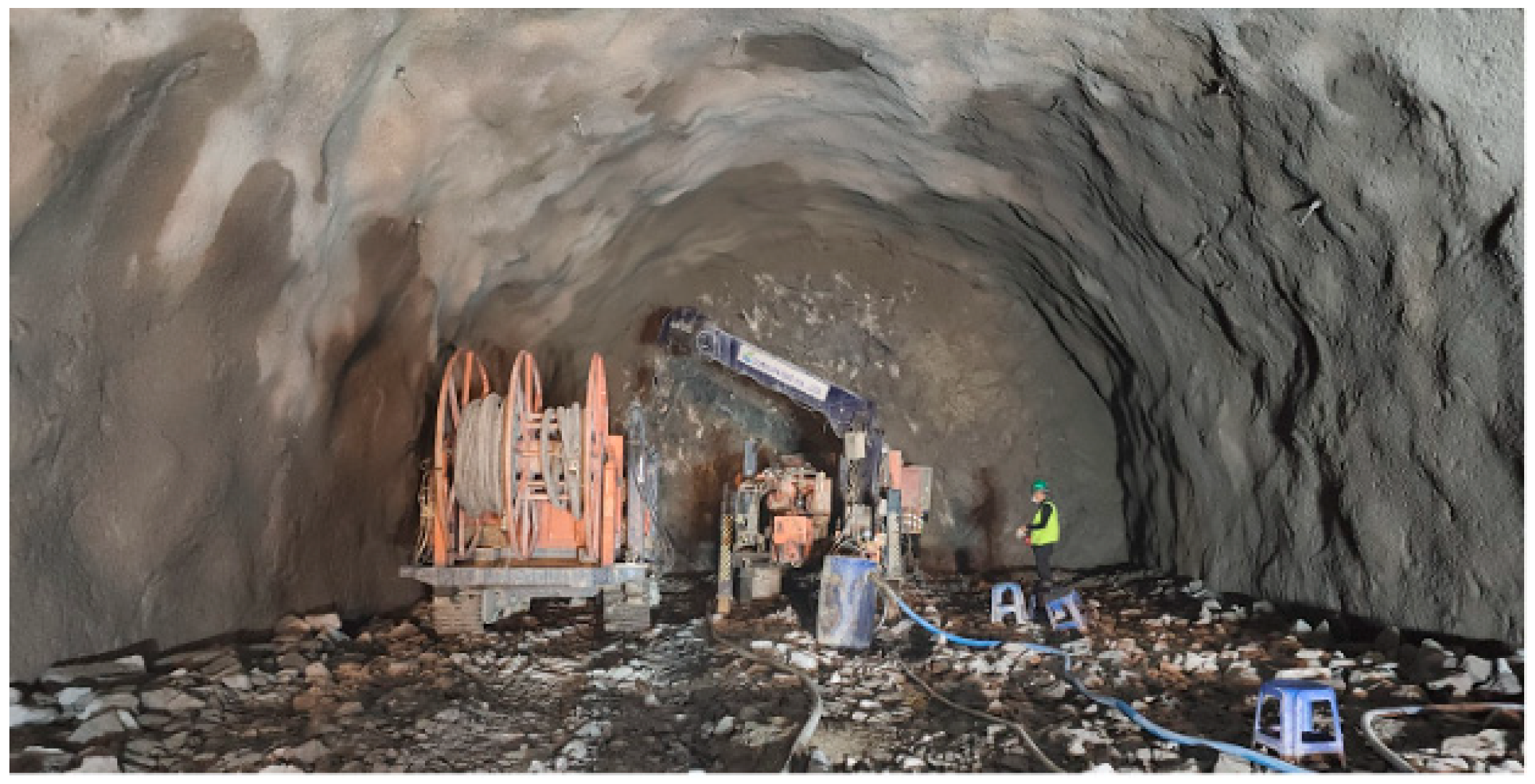
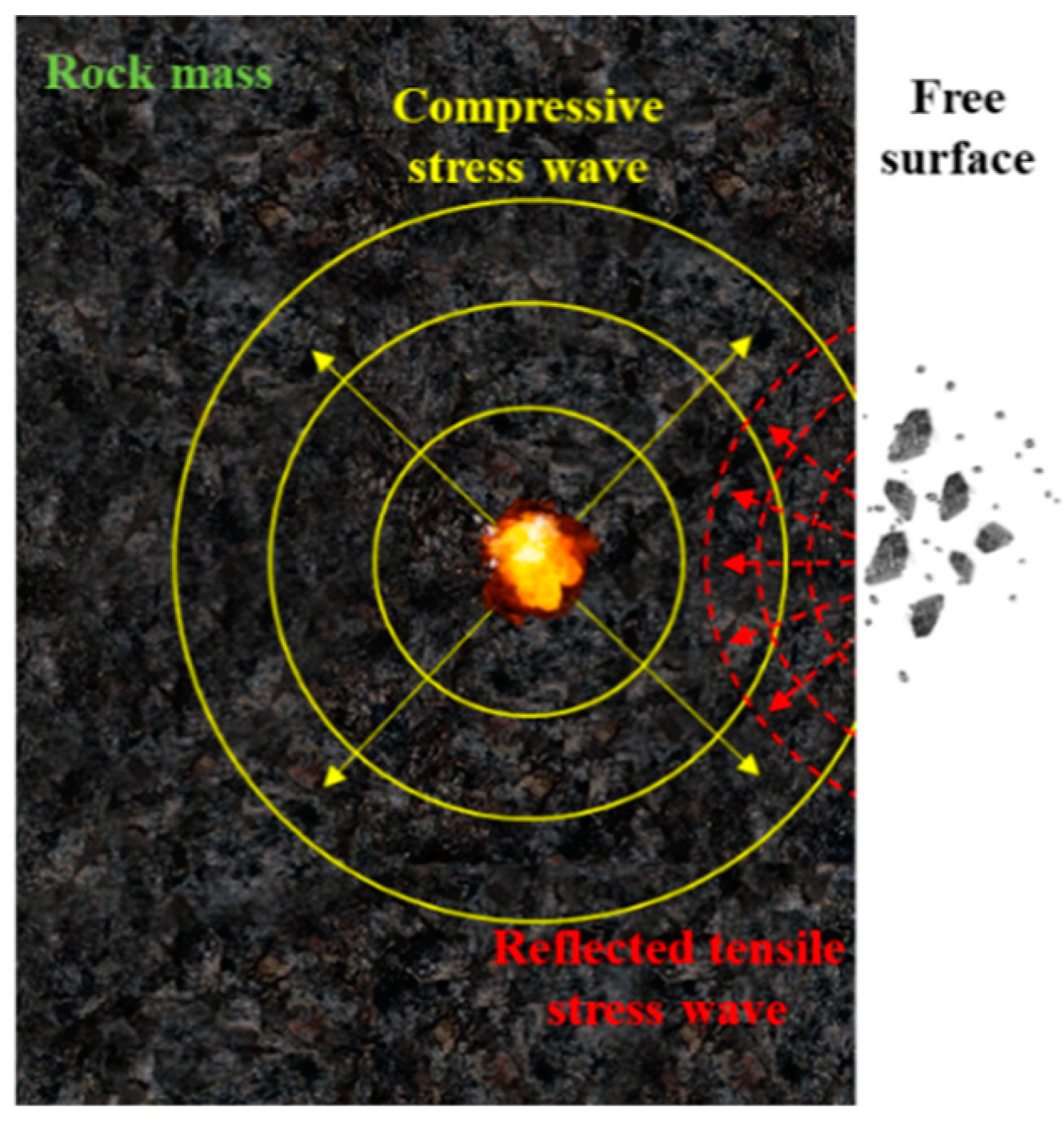
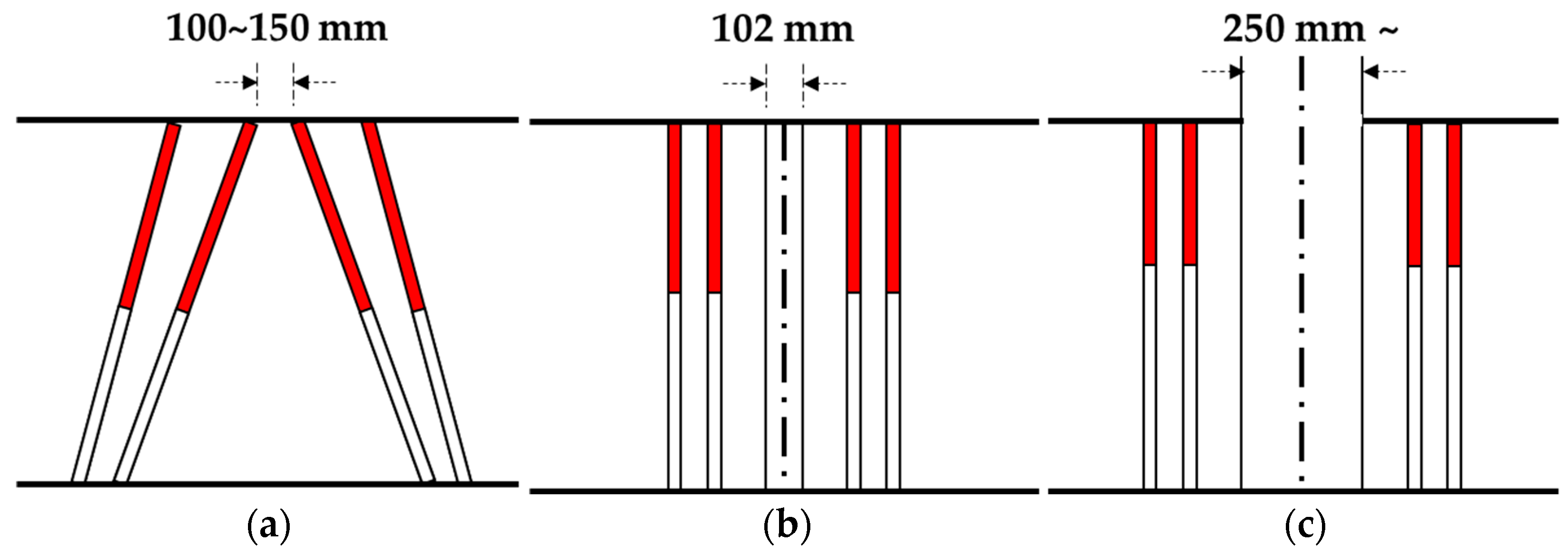

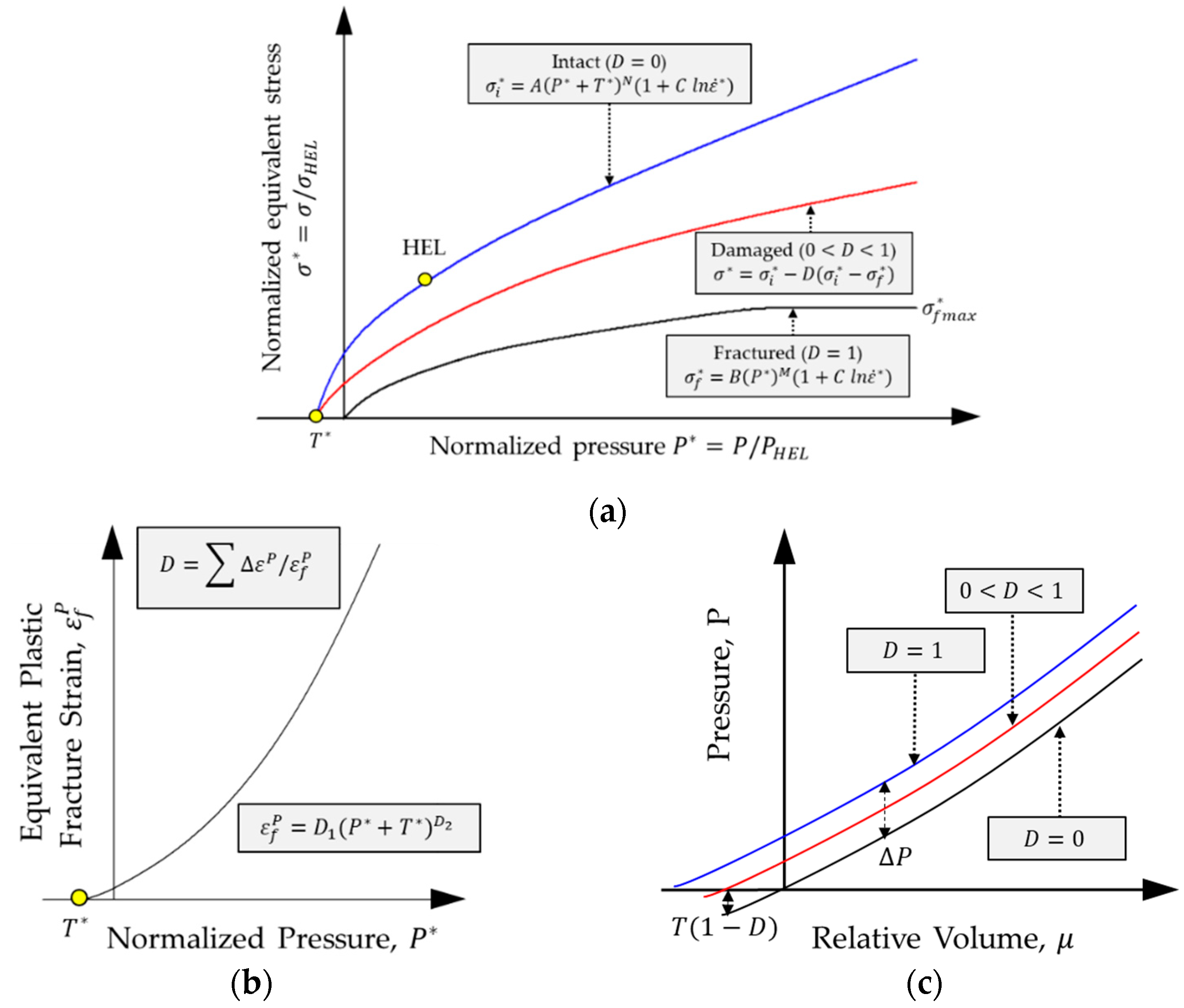
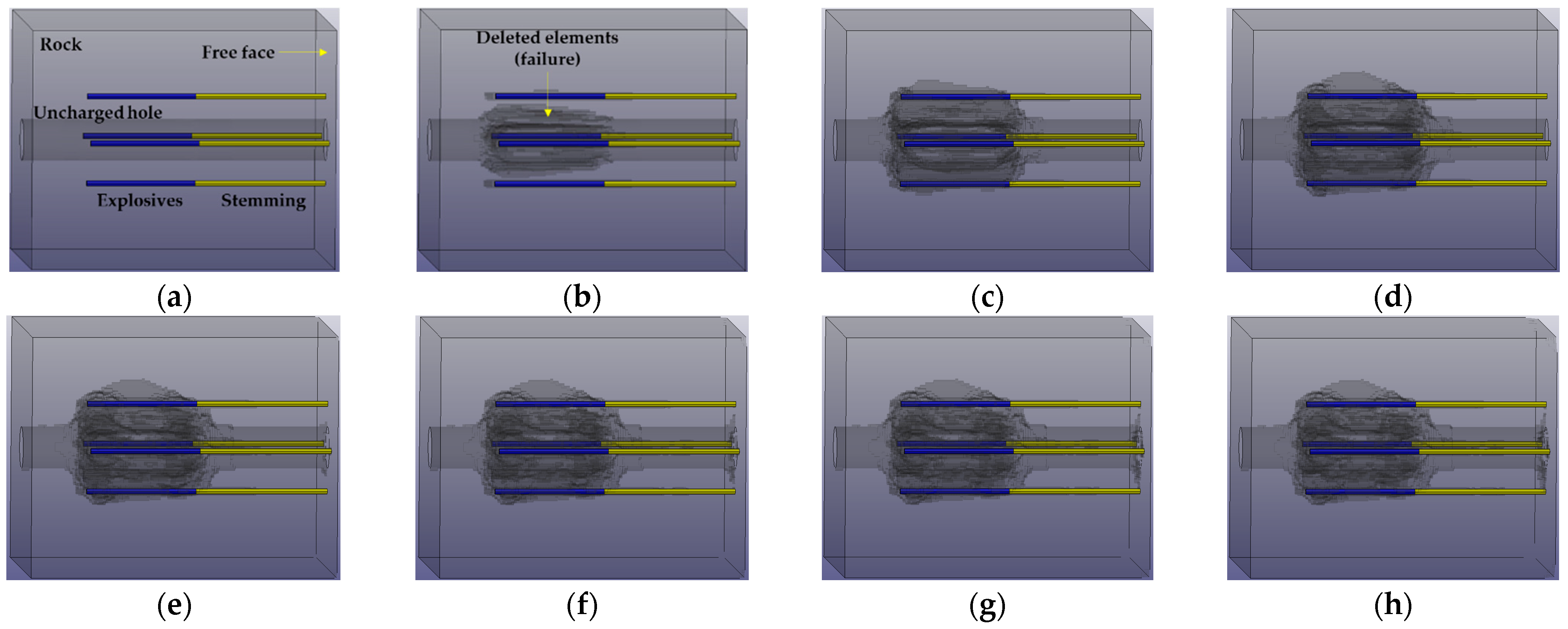


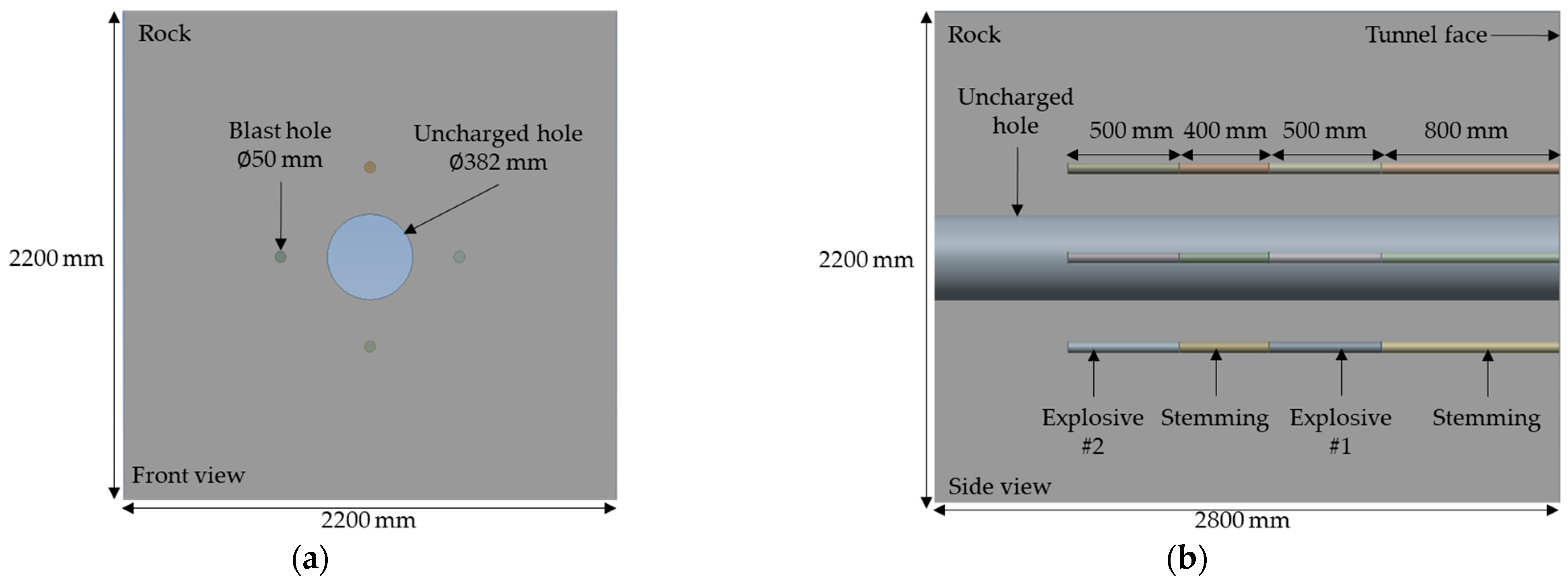
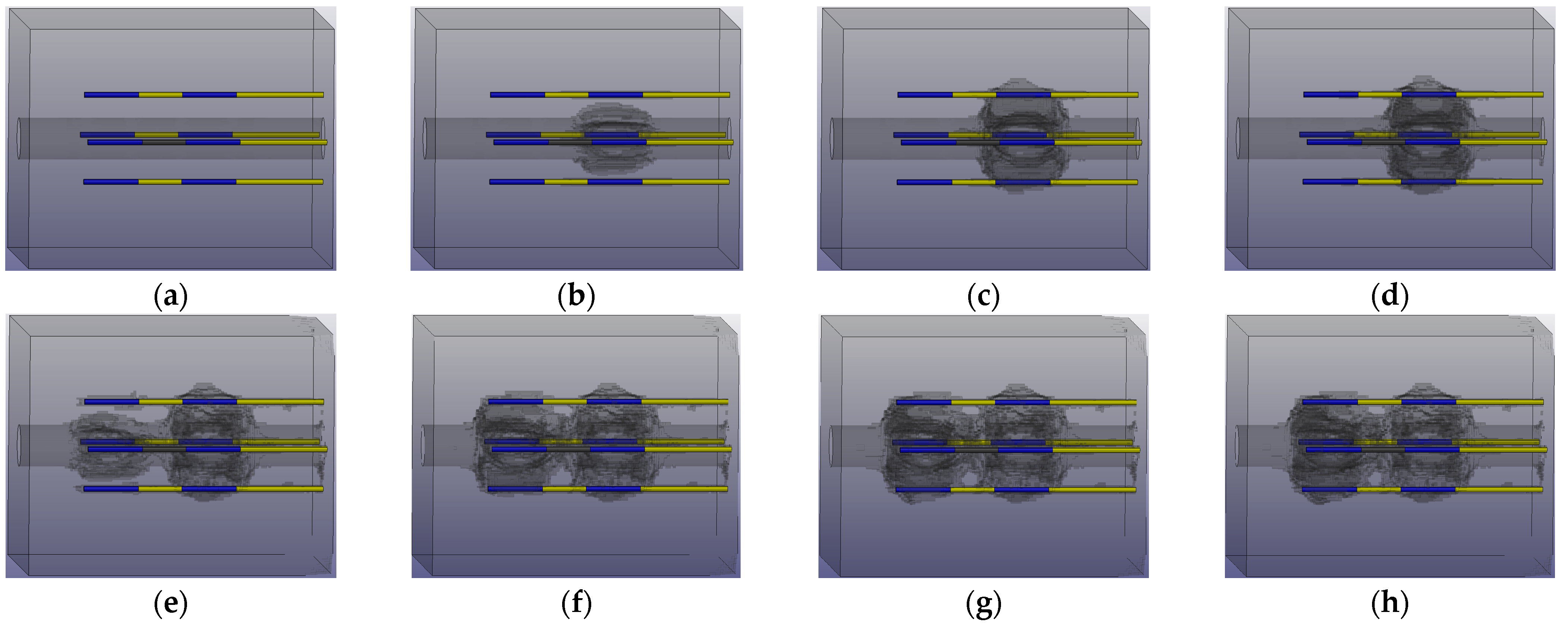
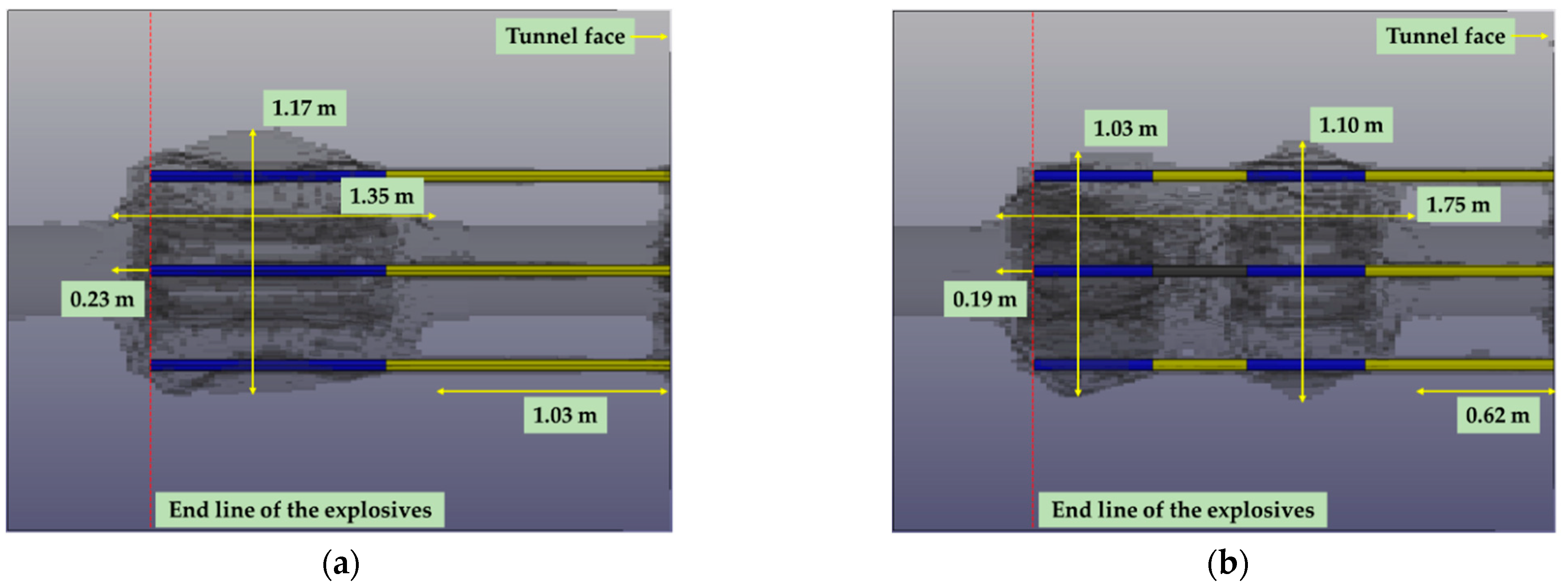
| Parameter | Value | Parameter | Value |
|---|---|---|---|
| Density () | 2560 | Maximum normalized fractured strength | 0.160 |
| Shear modulus () | 11.606 | Hugoniot elastic limit () | 4.500 |
| Intact normalized strength parameter A | 1.248 | Pressure component at the Hugoniot elastic limit () | 2.930 |
| Fractured normalized strength parameter B | 0.680 | Fraction of elastic energy loss | 1.000 |
| Strength parameter C | 0.005 | Plastic strain to fracture | 0.008 |
| Fractured strength parameter M | 0.830 | Plastic strain to fracture | 0.435 |
| Intact strength parameter N | 0.676 | First pressure coefficient K1 () | 10.720 |
| Reference strain rate | 1.000 | Second pressure coefficient K2 () | −386 |
| Maximum tensile strength () | 0.015 | Elastic constant K3 () | 12,800 |
| JWL | Parameter | A () | B () | () | () | |||
| Value | 276 | 8.44 | 5.215 | 2.112 | 0.501 | 3.868 | 1.0 | |
| High Explosives Burn | Parameter | RO () | D () | () | ||||
| Value | 1180 | 5122 | 9.530 | |||||
| Parameter | Value | Parameter | Value |
|---|---|---|---|
| Density () | 2350 | Specific gravity | 2.650 |
| Density of water () | 1000 | Skeleton bulk modulus () | 0.153 |
| Viscoplasticity parameter | 1.100 | Viscoplasticity parameter | 0.0 |
| Maximum number of plasticity iterations | 10.00 | Minimum internal friction angle (radians) | 0.063 |
| Bulk modulus () | 15.30 | Shear modulus () | 19.50 |
| Peak shear strength angle (radians) | 0.420 | Cohesion () | 0.011 |
| Eccentricity parameter | 0.700 | Moisture content | 6.200 |
| Volumetric strain at the initial damage threshold | 0.001 | Strain hardening, percent of where non-linear effects start | 10.00 |
| Pore–water effects on bulk modulus PWD1 | 0.0 | Pore–water effects on effective pressure PWD2 | 0.0 |
| Void formation energy | 10.00 | Strain hardening, amount of non-linear effects | 10.00 |
| 1.29 | 0.0 | 0.0 | 0.0 | 0.0 | 0.4 | 0.4 | 0.0 | 0.25 |
Disclaimer/Publisher’s Note: The statements, opinions and data contained in all publications are solely those of the individual author(s) and contributor(s) and not of MDPI and/or the editor(s). MDPI and/or the editor(s) disclaim responsibility for any injury to people or property resulting from any ideas, methods, instructions or products referred to in the content. |
© 2023 by the authors. Licensee MDPI, Basel, Switzerland. This article is an open access article distributed under the terms and conditions of the Creative Commons Attribution (CC BY) license (https://creativecommons.org/licenses/by/4.0/).
Share and Cite
Kim, M.-S.; Yoo, W.-K.; Kim, W.; Hwang, S.; Kim, C.-Y.; Lee, S.S. Numerical Study Investigating the Blasting Efficiency of the Long and Large-Diameter Uncharged Hole-Boring Method with Deck Charge Technique. Appl. Sci. 2023, 13, 2099. https://doi.org/10.3390/app13042099
Kim M-S, Yoo W-K, Kim W, Hwang S, Kim C-Y, Lee SS. Numerical Study Investigating the Blasting Efficiency of the Long and Large-Diameter Uncharged Hole-Boring Method with Deck Charge Technique. Applied Sciences. 2023; 13(4):2099. https://doi.org/10.3390/app13042099
Chicago/Turabian StyleKim, Min-Seong, Wan-Kyu Yoo, Wooseok Kim, Sungpil Hwang, Chang-Yong Kim, and Sean Seungwon Lee. 2023. "Numerical Study Investigating the Blasting Efficiency of the Long and Large-Diameter Uncharged Hole-Boring Method with Deck Charge Technique" Applied Sciences 13, no. 4: 2099. https://doi.org/10.3390/app13042099





